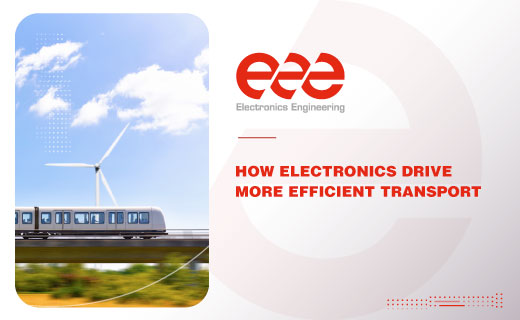The mobility of the future doesn’t depend solely on cleaner engines or modern infrastructure. Behind every real advancement, there’s something quieter yet equally decisive: the electronics that make a train consume less energy, last longer, and leave a much smaller environmental footprint. Today, railway sustainability cannot be understood without precisely applied electronic technology.
How Electronics Make Transport More Efficient
By nature, rail is one of the most efficient modes of transport in the world. In recent years, however, the leap in efficiency has been enormous, and much of the credit goes to electronics.
Control, monitoring, and energy management systems ensure that every train component operates only when necessary, detects anomalies in real time, and extends its lifespan. This translates into:
-
Lower energy consumption
Thanks to converters, sensors, and control systems that dynamically adjust energy usage. Nothing is wasted because everything is monitored. -
Reduced indirect emissions
A train that consumes less energy automatically lowers overall demand, reducing its environmental impact. -
Greater reliability
Advanced electronics prevent failures, improve performance, and reduce the need to manufacture new parts.
In other words: more sustainability, but also higher operational efficiency.
How Electronics Reduce Energy Consumption
Energy efficiency isn’t just about engines. Today, almost every energy-related decision originates in an electronic module. Key examples include:
-
Intelligent traction control
Optimizes the exact power needed for each section, avoiding unnecessary peaks. -
Regenerative braking systems
Recover part of the energy generated during braking to return it to the grid or reuse it within the train. -
Continuous monitoring
Sensors distributed along the train anticipate anomalous behavior that could increase energy use if not corrected in time.
Thanks to these systems, many railway operators have reduced energy consumption by 20–30%—a silent but significant improvement.
Electronic Recycling: A Key Piece in the Circular Economy
Sustainability also means thinking about the product lifecycle. Modern railway electronics are designed not only to last but also to be recyclable, upgradeable, and reintegrated into the system.
-
Many components can be refurbished and recovered.
-
Circuit boards can be updated without producing new ones from scratch.
-
Modular designs ensure that a single failure doesn’t require discarding an entire system.
This enables the industry to move toward a far more responsible model, where every component matters and nothing goes to waste.
Triple E’s Experience: Applied Efficiency and Sustainability
At Triple E, we have been working for years on projects where energy efficiency and sustainability are not add-ons but starting points. Some of the most notable efforts include:
-
Development and updating of electronic systems that extend rolling stock lifespan, avoiding premature replacements.
-
Advanced refurbishment and repair of equipment, reducing the need to manufacture new components.
-
Electronic control and monitoring solutions that improve operational efficiency of trains in service.
-
Modernization projects integrating current technologies into trains that still have many years of service, contributing to both their sustainability and that of the operator.
Our vision is clear: efficient rail transport starts with electronics… and responsible electronics begin with how they are designed, used, and recovered.










